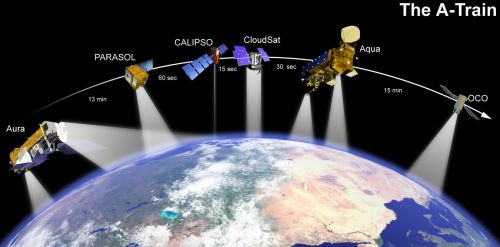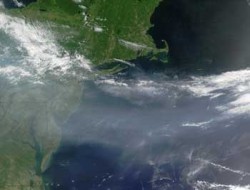This is one of the finest examples of satellite collaboration. Five Earth-observing orbiters, four from NASA and one from France, are working together to provide the deepest analysis of cloud cover ever carried out. The satellites orbit in a close formation, only eight minutes apart, and create what is known as the “Afternoon Constellation” (or “A-Train” for short). They are so close in fact, that they can be considered to act as one satellite, capable of carrying out a vast suite of measurements on the pollution content of clouds. This work is shedding new light on the link between clouds, pollution and rainfall, a study that could never be achieved with one satellite alone…
Pollution in clouds is a critical problem for the international community. These rogue particles can seriously change the natural behaviour of clouds and entire weather systems, but until now, scientists have been uncertain about the difference in rainfall from polluted and unpolluted cloud cover. This is primarily because no single environmental satellite has been able to probe deep into clouds with the limited number of instruments it can carry. But using the collective power of five independent satellites, scientists are beginning to unlock the secrets polluted clouds have been hiding.
Researchers at NASA’s Jet Propulsion Labs (JPL) in Pasadena have recently discovered that clouds peppered with pollutant particles do not produce as much rain as their unpolluted counterparts. This finding was only possible after analysing data from the near-simultaneous measurements made by the five A-Train satellites. The constellation includes NASA’s Aqua, Aura, CloudSat and CALIPSO and the French Space Agency’s PARASOL.
“Typically, it is very hard to get a sense of how important the effect of pollution on clouds is. With the A-Train, we can see the clouds every day and we’re getting confirmation on a global scale that we have an issue here.” – Anne Douglass, project scientist at Goddard for NASA’s Aura satellite.
The A-Train is turning up some interesting, if alarming, results. When focusing on the skies above South America during the June-October dry season, the JPL team found that the increased level of agricultural burning during this period injected more aerosols into the clouds. This had the effect of shrinking the size of ice crystals in the clouds, preventing the crystals from getting large enough to fall as rain. This direct effect of burning and ice crystal formation has never been connected before the use of the A-Train. However, during wet seasons, the aerosol content in clouds appeared not to be a critical factor on the amount of rainfall.
How is it possible to distinguish between polluted and unpolluted clouds? Firstly, the A-Train’s Aura satellite measures the concentration of carbon monoxide in the clouds. This is a strong indicator for the presence of smoke and other aerosols originating from a power plant or agricultural activities. When the polluted clouds are identified, the A-Train’s Aqua satellite can be called into use. Using its Moderate Resolution Imaging Spectroradiometer instrument, the size of ice crystals in polluted and unpolluted clouds can be measured. Next up is NASA’s Tropical Rainfall Measuring Mission satellite that can measure the amount of precipitation (rain) from polluted and unpolluted clouds.
Through this combination of satellites, scientists are able to link pollution with clouds with precipitation. This is only one example of the flexibility behind collaborations such as A-Train, so cloud science can only go from strength to strength.
Source: Physorg.com



It is good to study the effects of pollution. I am all for reducing pollution and we have come a long way in cleaning up the environment. This should help catch cheaters. As technology increases, we can do more. Ironically, developing countries had a 30 year lag in the 90s to afford the equipment to do this. Perhaps we should focus on helping them control their pollution. That would help everyone everywhere. They could then invest the money back into their economies and raise their people. They can then buy from us. We recoup our investment many times.
It would be nice to know the relationship betwixt aerosols, colloids, particulates, salts, etc and crystal size and formation. I thought nucleation enhances crystal & rain formation? Aerosolized Sea Salt’s supposed to produce Pacific storms. Barium Sulphates in chemtrails supposedly distort radar. Cumulus-Nimbus clouds result from strong humid updrafts (esp tropical). I guess snow machines have their own ionic salt formulae.
This article states that pollutants lowered rainfall, why so? Dry Ice (CO2) precipitates cloud formation and rain in bulk thrown out of planes. Silver Iodide is more effective or parsimonious- a little goes a long way. China deploys its own ‘Rainmaking’ squad for the august Olympics, which occurs during Beijings rainy season. What might work in my Rainmaker? Tell me truly I implore, only this & nothing more. Les
Hi David.
Yes, I think you are right, high levels of CO highlight clouds containing polluting particles. I’m sure natural sources cause this too, but it depends on the source. Like during periods of high agri burning, larger presence of CO. Also (what I can understand from reading the A-Train research), scientists should be able to link polluted cloud with the source of the pollution too, might help with the identification of industrial polluters.
It’s all very interesting research Nice to know satellites are teaming up!
Nice to know satellites are teaming up!
Cheers, Ian
“How is it possible to distinguish between polluted and unpolluted clouds? Firstly, the A-Train’s Aura satellite measures the concentration of carbon monoxide in the clouds. This is a strong indicator for the presence of smoke and other aerosols originating from a power plant or agricultural activities.”
This claim implies that carbon monoxide exists in higher concentrations that originate from artificial sources. Overall, the article was silent on other potential sources of carbon monoxide. Does that mean that natural sources do not emit carbon monoxide? Does that mean that our research abilities can pinpoint pollution based on carbon monoxide levels? I am assuming that yes, this is the case with regard to both questions. Still think it’s worth asking the question. No, I am not a right-wing conspiracy theorist/alarmist attempting to debunk an article related to human-based global warming. Just a mild mannered tree hugger asking a question.
Ian,
This sounds like a significant development if in fact they can pinpoint polluters. The cynic in me says that the contributors to such pollutants will not care. But at the very least, it’s one step closer to making a graphic case to the damage we’re doing to our Deep Blue. Thanks for another excellent article.
It’s an interesting example of collaborative satellite use, as well as an intriguing method of problem solving.
I agree with David in that it at least is a step to building a strong case .
I also wonder, are the satellites in the A-Train all completely different, or do they have some common instruments? If so, is it possible to also combine these to provide better detail or resolution, or does it not work that way?